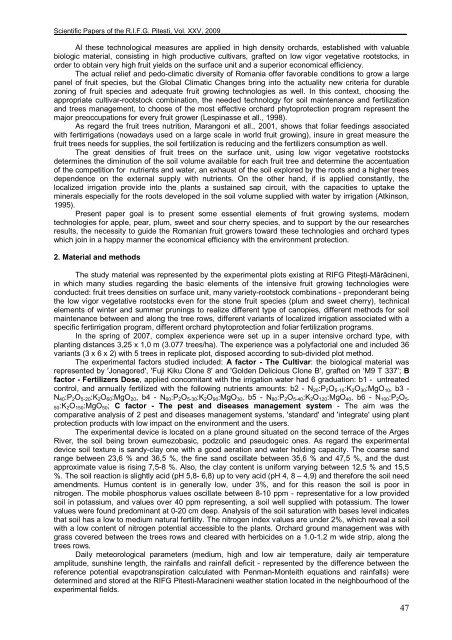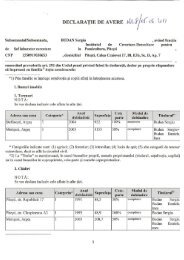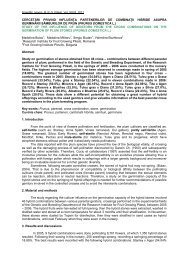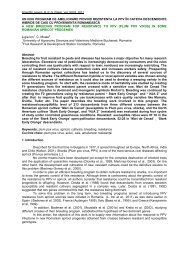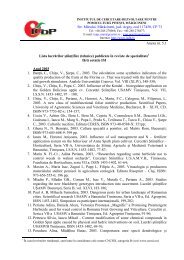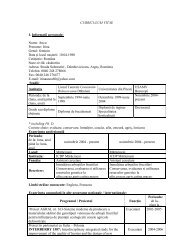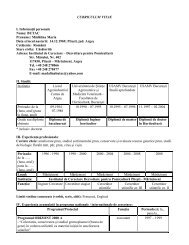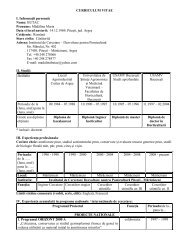46 prezent şi perspectivă în tehnologiile pomicole din românia în ...
46 prezent şi perspectivă în tehnologiile pomicole din românia în ...
46 prezent şi perspectivă în tehnologiile pomicole din românia în ...
You also want an ePaper? Increase the reach of your titles
YUMPU automatically turns print PDFs into web optimized ePapers that Google loves.
Scientific Papers of the R.I.F.G. Pitesti, Vol. XXV, 2009_________________________________________________<br />
Al these technological measures are applied in high density orchards, established with valuable<br />
biologic material, consisting in high productive cultivars, grafted on low vigor vegetative rootstocks, in<br />
order to obtain very high fruit yields on the surface unit and a superior economical efficiency.<br />
The actual relief and pedo-climatic diversity of Romania offer favorable conditions to grow a large<br />
panel of fruit species, but the Global Climatic Changes bring into the actuality new criteria for durable<br />
zoning of fruit species and adequate fruit growing technologies as well. In this context, choosing the<br />
appropriate cultivar-rootstock combination, the needed technology for soil maintenance and fertilization<br />
and trees management, to choose of the most effective orchard phytoprotection program represent the<br />
major preoccupations for every fruit grower (Lespinasse et all., 1998).<br />
As regard the fruit trees nutrition, Marangoni et all., 2001, shows that foliar fee<strong>din</strong>gs associated<br />
with fertirrigations (nowadays used on a large scale in world fruit growing), insure in great measure the<br />
fruit trees needs for supplies, the soil fertilization is reducing and the fertilizers consumption as well.<br />
The great densities of fruit trees on the surface unit, using low vigor vegetative rootstocks<br />
determines the diminution of the soil volume available for each fruit tree and determine the accentuation<br />
of the competition for nutrients and water, an exhaust of the soil explored by the roots and a higher trees<br />
dependence on the external supply with nutrients. On the other hand, if is applied constantly, the<br />
localized irrigation provide into the plants a sustained sap circuit, with the capacities to uptake the<br />
minerals especially for the roots developed in the soil volume supplied with water by irrigation (Atkinson,<br />
1995).<br />
Present paper goal is to present some essential elements of fruit growing systems, modern<br />
technologies for apple, pear, plum, sweet and sour cherry species, and to support by the our researches<br />
results, the necessity to guide the Romanian fruit growers toward these technologies and orchard types<br />
which join in a happy manner the economical efficiency with the environment protection.<br />
2. Material and methods<br />
The study material was represented by the experimental plots existing at RIFG Piteşti-Mărăcineni,<br />
in which many studies regar<strong>din</strong>g the basic elements of the intensive fruit growing technologies were<br />
conducted: fruit trees densities on surface unit, many variety-rootstock combinations - preponderant being<br />
the low vigor vegetative rootstocks even for the stone fruit species (plum and sweet cherry), technical<br />
elements of winter and summer prunings to realize different type of canopies, different methods for soil<br />
maintenance between and along the tree rows, different variants of localized irrigation associated with a<br />
specific fertirrigation program, different orchard phytoprotection and foliar fertilization programs.<br />
In the spring of 2007, complex experience were set up in a super intensive orchard type, with<br />
planting distances 3,25 x 1,0 m (3.077 trees/ha). The experience was a polyfactorial one and included 36<br />
variants (3 x 6 x 2) with 5 trees in replicate plot, disposed accor<strong>din</strong>g to sub-divided plot method.<br />
The experimental factors studied included: A factor - The Cultivar: the biological material was<br />
represented by 'Jonagored', 'Fuji Kiku Clone 8' and 'Golden Delicious Clone B', grafted on ‘M9 T 337’; B<br />
factor - Fertilizers Dose, applied concomitant with the irrigation water had 6 graduation: b1 - untreated<br />
control, and annually fertilized with the following nutrients amounts: b2 - N20:P2O5-10:K2O30:MgO10, b3 -<br />
N40:P2O5-20:K2O60:MgO20, b4 - N60:P2O5-30:K2O90:MgO30, b5 - N80:P2O5-40:K2O120:MgO40, b6 - N100:P2O5-<br />
50:K2O150:MgO50; C factor - The pest and diseases management system - The aim was the<br />
comparative analysis of 2 pest and diseases management systems, 'standard' and 'integrate' using plant<br />
protection products with low impact on the environment and the users.<br />
The experimental device is located on a plane ground situated on the second terrace of the Arges<br />
River, the soil being brown eumezobasic, podzolic and pseudogeic ones. As regard the experimental<br />
device soil texture is sandy-clay one with a good aeration and water hol<strong>din</strong>g capacity. The coarse sand<br />
range between 23,6 % and 36,5 %, the fine sand oscillate between 35,6 % and 47,5 %, and the dust<br />
approximate value is rising 7,5-8 %. Also, the clay content is uniform varying between 12,5 % and 15,5<br />
%. The soil reaction is slightly acid (pH 5,8- 6,8) up to very acid (pH 4, 8 – 4,9) and therefore the soil need<br />
amendments. Humus content is in generally low, under 3%, and for this reason the soil is poor in<br />
nitrogen. The mobile phosphorus values oscillate between 8-10 ppm - representative for a low provided<br />
soil in potassium, and values over 40 ppm representing, a soil well supplied with potassium. The lower<br />
values were found predominant at 0-20 cm deep. Analysis of the soil saturation with bases level indicates<br />
that soil has a low to medium natural fertility. The nitrogen index values are under 2%, which reveal a soil<br />
with a low content of nitrogen potential accessible to the plants. Orchard ground management was with<br />
grass covered between the trees rows and cleared with herbicides on a 1.0-1.2 m wide strip, along the<br />
trees rows.<br />
Daily meteorological parameters (medium, high and low air temperature, daily air temperature<br />
amplitude, sunshine length, the rainfalls and rainfall deficit - represented by the difference between the<br />
reference potential evapotranspiration calculated with Penman-Monteith equations and rainfalls) were<br />
determined and stored at the RIFG Pitesti-Maracineni weather station located in the neighbourhood of the<br />
experimental fields.<br />
47


